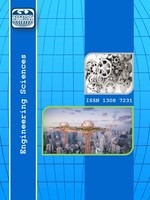THE INVESTIGATION OF WEAR PROPERTIES OF TIN COATINGS ON THE H13 TOOL STEEL UNDER DIFFERENT DEPOSITION PARAMETERS
PVD, Wear, Coating, Working Pressure, TiN
THE INVESTIGATION OF WEAR PROPERTIES OF TIN COATINGS ON THE H13 TOOL STEEL UNDER DIFFERENT DEPOSITION PARAMETERS
PVD, Wear, Coating, Working Pressure, TiN,
___
- [1] Kola, P.V., et al., (1996). Magnetron sputtering of Tin Protective Coatings for Medical Applications. Journal of Materials Processing Technology, 56(1):422-430.
- [2] Mills, B., (1996). Recent developments in Cutting Tool Materials. Journal of Materials Processing Technology, 56(1):16-23.
- [3] Bahri, A., et al., (2015). Tribological performance of TiN Coatings Deposited on 304L Stainless Steel Used for Olive-Oil Extraction. Wear, 342:77-84.
- [4] Pihosh, Y., et al., (2005). Influence of Reacting Nitrogen Gas Consistence on The Properties of TiN Films Prepared by rf. magnetron sputtering. Applied Surface Science, 244(1):244-247.
- [5] Wrehde, S., et al., (2008). Optical and Chemical characterization of Thin TiNx Films Deposited by DC-magnetron Sputtering. Vacuum, 82(10):1115-1119.
- [6] Ma, L.W., et al., (2010). Effect of Coating Thickness on the Deformation Mechanisms in PVD TiN-coated Steel. Surface and Coatings Technology, 204(11):1764-1773.
- [7] Luo, Q., Yang, S., and Cooke, K.E., (2013). Hybrid HIPIMS and DC Magnetron Sputtering Deposition of TiN Coatings: Deposition Rate, Structure and Tribological Properties. Surface and Coatings Technology, 236:3-21.
- [8] Chavda, M.R., et al., (2016). Tribological Characterization of TiN Coatings Prepared by Sputtering. Procedia Technology, 23:36-41.
- [9] Shukla, K., et al., (2017). Structural, Mechanical and Corrosion Resistance Properties of Ti/TiN Bilayers Deposited by Magnetron Sputtering on AISI 316L. Surface and Coatings Technology, 324:167-174.
- [10] Safi, I., (2000). Recent Aspects Concerning DC Reactive Magnetron Sputtering of Thin Films: A Review. Surface and Coatings Technology, 127(2):203-218.
- Başlangıç: 2009
- Yayıncı: E-Journal of New World Sciences Academy
VEYN KESME DENEYİ İLE SİLTLİ ZEMİNLERİN KAYMA DAYANIMINA KİL YÜZDESİNİN ETKİSİNİN İNCELENMESİ
Hojjat GHAHRAMANZADEH ASL, Levent KARA, Yaşar SERT, Tugay SONSUZ SERT, Tevfik KÜÇÜKÖMEROĞLU
GRİ DÖKME DEMİRLERİN KATILAŞMA MODELLEMESİ VE GERÇEK DÖKÜMLER İLE KARŞILAŞTIRMASI
Murat ÇOLAK, İbrahim ARSLAN, Esma GAVGALI
Sinem BUYUKSAATCI KIRIS, Mesut SAMASTI, Ş. Alp BARAY
DETERMINING THE BEST SUITABLE CONTROL STRATEGY OF THE VSC-HVDC FOR VOLTAGE STABILITY
Esra TUĞRUL TUNÇ, Kürşat Esat ALYAMAÇ, Ragıp İNCE, Zülfü Çınar ULUCAN
TRAMVAYIN KAMPÜS YERLEŞKESİ İÇİNE ENTEGRASYONUNUN YAYA GÜVENLİĞİ AÇISINDAN DEĞERLENDİRİLMESİ
